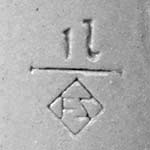
by Walter Swett
Starting with the first Oktoberfest in 1810, beer has always been an integral part of the celebration of the marriage of Crown Prince Ludwig of Bavaria and Princess Therese of Saxony-Hildburghausen. Of course in order for one to consume the “liquid bread,” a good quality drinking vessel was needed, hence the birth of the Oktoberfest beer mug and stein. As we all know, where there are mugs and steins, collectors are not far behind.
The Jahreskrug is produced by Rastal GmbH & Co. KG, located in Höhr-Grenzhausen in the Westerwald region of Germany. This region is known as the Kannenbächerland or Land of the Pot Bakers because of the abundant availability of the clay needed to produce stoneware. The Jahreskrug is manufactured in the Keferloher style which is a simple clay mug. The name Keferloher originates from a small town near Munich where as early as the 19th century there was a cattle market where people would gather and drink beer from this style of clay mugs. Although not produced in Keferloh, the name Kefeloher became commonly used to describe this style.
 |
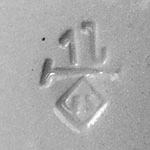 |
The first post-World War II Oktoberfest celebration was held in 1949. As part of the effort to restore the annual celebration to its pre-war status, the City of Munich’s Office of Tourism launched the first Oktoberfest-Plakatwettbewerb in 1952. The idea was to use the winning designs to advertise the Oktoberfest in train stations throughout neighboring countries.
From inception until 1979, the competitions were closed with the only eligible artists being those that received invitations to participate. The majority of invitees were artists with Munich roots and as a result, some of the early design competitions were won multiple times by the same artists. For example, Ernst Strom had the winning posters in 1957, 1958, 1967, and 1981 and Ernst Wild took the prize in 1960, 1961, 1962, 1963, and 1965. Starting in 1980, the competitions began rotating between closed and open. The open competitions brought many more entries and as a result became very labor intensive and expensive to judge. In 2000, the competitions were again restricted to a select group of artists. Today, the submissions are selected by the Plakatjury or Poster Jury, which is comprised of members of the Oktoberfest Committee of the City Counsel, artists, and technicians within the field of graphic arts.1
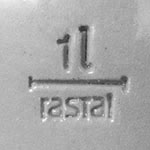 |
From 1978 until 1984 the production of the mugs was subcontracted to Franz Stöber. Stöber was identified by the initials “FS” which were inside a diamond stamped into the mug beneath the capacity mark on the left side.3 Two different styles of the mark have been seen (Figs. 1 & 2).
By 1985 it was evident that the mugs were popular enough to warrant their own production run at Rastal. The “FS” was dropped and the word “rastal” replaced it (Fig. 3). In 1990, the capacity mark was moved from the left to the right side.4
On all but the 1979 edition, in addition to the “FS” stamp below the capacity mark, the Rastal trademark is found on the bottom along with “Höhr-Grenzhausen”. The editions from 1980–1984 also display the year of production on the right side of the Rastal stamp. The signature of the artist can be found on the bottom of each of the mugs and steins as well (Fig. 4). In 2002 “MADE IN GERMANY” was added to the bottom markings.
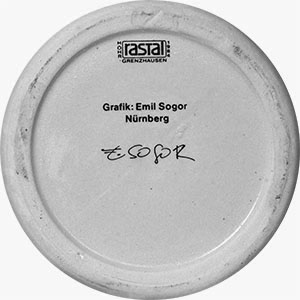 |
Starting in 1987, Rastal began creating lids designed specifically for the Jahreskrug series and accompanying them with certificates which provide, among other information, explanations for each of the lid designs.
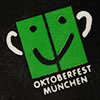 |
Since the advent of the Jahreskrug, the winning image from the Oktoberfest-Plakattwettbewerb has found its way onto pins, T-shirts, hats and other items that are sold as souvenirs. According to a 2002 article published at www.ganz-muenchen.de (no longer available online), the Jahreskrug “has become the most lucrative selling item emblazoned with the official Oktoberfest design.”
What will the future bring for the Oktoberfest Jahreskrug? Who knows? We’ll just have to wait and see. One thing I am certain of, with each new release new collectors are born and as more people begin collecting the Jahreskrug, the demand for the early issues increases and consequently, so does their value, with current auction prices for the 1978 Jahreskrug averaging better than $400. The more recent issues are still easy to obtain and very inexpensive, making the collecting of Oktoberfest Jahreskrüge an excellent way to enter the fascinating hobby of beer stein collecting.
Acknowledgements:
I would like to thank SCI member Mr. Ron Gray for sharing his email from Melanie Colmi with me, and Mr. Walter Mück, who over the years has been kind enough to answer many questions I’ve had about my collection. My wife Gabriele and daughter Stefanie have been indispensable in the assistance they provided with translations and last but not least, my daughter Inga Marone who assisted with editing my work.
References:
1Dering, Florian: “Mass Für Mass Das Oktoberfest-Plakat Der Landeshauptstadt München 1952- 2002”, Münchner Stadtmuseum, Fremdenverkehrsamt München, Münchner Oktoberfestmuseum e.V., 2002.
2Finke, Uwe (Curator of the Rastal Historic Drinking Vessel Collection in Germany): “The Oktoberfest Commemorative Mug.”
3Colmi, Melanie, Marketing Assistant, Rastal GmbH & Co. KG: Email, June 5, 2003.
4Ibid.
5Mück, Walter: Oktoberfest-Krüge, Vol. 1, Athesia Druck - Bozen, 1991, 143 pp.
6Mück, Walter: Gesamtband Oktoberfest-Krüge bis 2006, Athesia Druck - Bozen, 2007, 91 pp.
__________
*Portions of these “Notes” first appeared in Prosit, the Journal of Stein Collectors International, Vol. 2 No. 74, June 2010, and have been modified and reproduced by permission and with the assistance of the author.
Modified content © 2010 Beer Stein Library — All rights reserved.